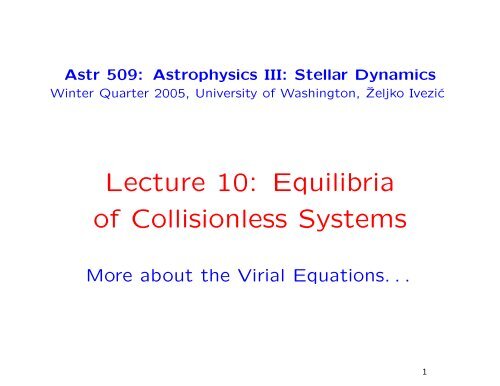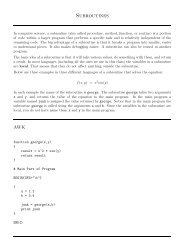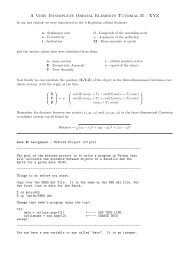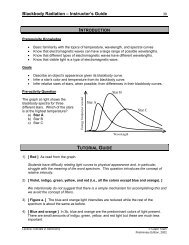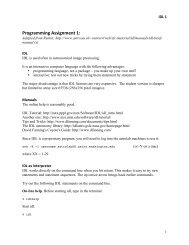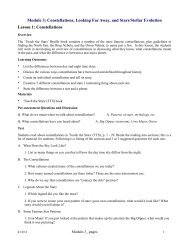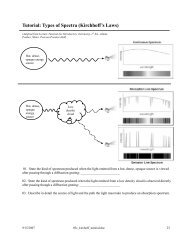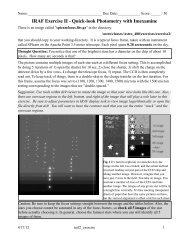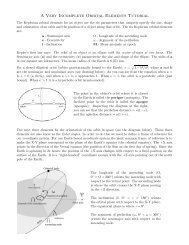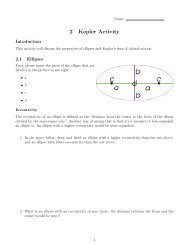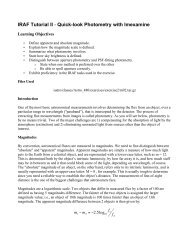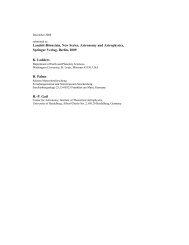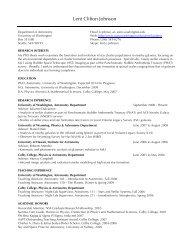Lecture 10
Lecture 10
Lecture 10
You also want an ePaper? Increase the reach of your titles
YUMPU automatically turns print PDFs into web optimized ePapers that Google loves.
Astr 509: Astrophysics III: Stellar Dynamics<br />
Winter Quarter 2005, University of Washington, Željko Ivezić<br />
<strong>Lecture</strong> <strong>10</strong>: Equilibria<br />
of Collisionless Systems<br />
More about the Virial Equations. . .<br />
1
The Midterm Exam Stats<br />
2
The Virial Theorem<br />
• In a system of N particles, gravitational<br />
forces tend to pull the<br />
system together and the stellar<br />
velocities tend to make it fly<br />
apart. It is possible to relate kinetic<br />
and potential energy of a<br />
system through the change of its<br />
moment of intertia<br />
• In a steady-state system, these<br />
tendencies are balanced, which is<br />
expressed quantitatively through<br />
the the Virial Theorem.<br />
• A system that is not in balance<br />
will tend to move towards its virialized<br />
state. (see fig. 4.19 in the<br />
textbook)<br />
3
The Virial Theorem(s)<br />
• The Scalar Virial Theorem tells us that the average kinetic<br />
and potential energy must be in balance.<br />
• The tensor Virial Theorem tells us that the kinetic and potential<br />
energy must be in balance in each separate direction.<br />
• The scalar virial theorem is useful for estimating global average<br />
properties, such as total mass, escape velocity and<br />
relaxation time, while the tensor virial theorem is useful for<br />
relating shapes of systems to their kinematics, e.g. the flatness<br />
of elliptical galaxies to their rotational speed (for a wide<br />
range of applications, see Chandrasekhar (1987, Ellipsodial<br />
Figures of Equilibrium, New York: Dover).<br />
• Remember that the virial theorem is a good intuitive tool but<br />
one that can be dangerous to put to quantitative use (King,<br />
unpublished).<br />
5
The Virial Theorem<br />
Zwicki’s derivation: (Ap. J. 1937, 86, 217)<br />
where ⃗ F i is the total forces on galaxy i.<br />
m i<br />
d 2 ⃗x i<br />
dt 2 = ⃗ F i (1)<br />
Scalar multiplication with ⃗x i gives:<br />
1<br />
2<br />
d 2<br />
(<br />
dt 2(m ix 2 i ) = ⃗x i · ⃗F d⃗xi<br />
i + m i<br />
dt<br />
) 2<br />
(2)<br />
(summing over all system particles is implied). The term on the<br />
left side represents the change of the momentum of inertia, the<br />
second term on the right side is related to kinetic energy, and<br />
the first term on the right side is called virial.<br />
6
The Virial Theorem<br />
It can be shown (the so-called Euler theorem from classical mechanics)<br />
that for Φ ∝ 1/r<br />
∑<br />
⃗xi · ⃗F i = ∑ ⃗x i · ∇Φ = −Φ (3)<br />
That is, the virial is related to potential energy of the system<br />
(true for any homogeneous function of the order k such that<br />
Φ(λx) = λ k Φ(x) – the virial is equal to kΦ).<br />
In a steady state,<br />
1<br />
2dt 2(m ix 2 i ) = 0, (4)<br />
and, for a self-gravitating system in steady state<br />
d 2<br />
2K + Φ = 0 (5)<br />
where K = M < v 2 > /2 is the kinetic energy. Thus,<br />
E = K + Φ = −K = 1 2 Φ (6)<br />
7
The Scalar Virial Theorem: Applications<br />
• If a system collapses from infinity, half of the potential energy<br />
will end up in kinetic energy, and the other half will be<br />
disposed of! From the measurement of the circular velocity<br />
and the mass of Milky Way (which constrain the kinetic<br />
energy), we conclude that during their formation, galaxies<br />
radiate away about 3 × <strong>10</strong> −7 of their rest-mass energy.<br />
• For a virialized spherical system, M = 2Rσ 2 /G. We can<br />
estimate total mass from the size and velocity dispersion.<br />
E.g. for a cluster with σ=12 km/s, and R=3 pc, we get<br />
M = 2 × <strong>10</strong> 5 M ⊙ (note that G = 233 in these units)<br />
8
The Tensor Virial Theorem<br />
Just as we took velocity moments of the collisionless Boltzmann<br />
equation (CBE) to obtain the Jeans equations, we can now take<br />
spatial moments of the CBE. If we multiply the CBE by x k and<br />
integrate over space we obtain<br />
∫<br />
∫<br />
∂(νv j )<br />
x k d 3 x = −<br />
dt<br />
∂(νv i v j )<br />
x k d 3 x −<br />
∂x i<br />
∫<br />
νx k<br />
∂Φ<br />
∂x j<br />
d 3 x. (7)<br />
The second term on the right hand side can be identified with the<br />
Chandrasekhar potential energy tensor, W. The first term<br />
on the right hand side can be rewritten using the divergence<br />
theorem:<br />
∫<br />
∫<br />
∂(νv i v j )<br />
x k d 3 x = − δ ki νv i v j d 3 x = −2K kj , (8)<br />
∂x i<br />
where we have defined the kinetic energy tensor K by<br />
K jk ≡ 1 2<br />
∫<br />
νv i v j d 3 x. (9)<br />
9
As with the velocity moments we can split up K into ordered<br />
and random parts:<br />
K jk = T jk + 1 2 Π jk, (<strong>10</strong>)<br />
where<br />
T jk ≡ 1 2<br />
∫<br />
νv j v k d 3 x ; Π jk ≡<br />
∫<br />
νσ jk d 3 x. (11)<br />
If we now symmetrize equation (7) about the indices k and j,<br />
we have<br />
∫<br />
1 d<br />
ν(x k v j + x j v k )d 3 x = 2T jk + Π jk + W jk , (12)<br />
2dt<br />
where we have used the symmetry of T, Π and W in their indices.<br />
If we now introduce the moment of inertia tensor I<br />
I jk ≡<br />
The derivative of this with respect to time is<br />
dI jk<br />
dt<br />
=<br />
∫<br />
νx j x k d 3 x. (13)<br />
∫ ∂ν<br />
∂t x jx k d 3 x. (14)
We can use continuum equation to change the right side of the<br />
equation to<br />
∫ ∫<br />
∂(νvi )<br />
− x j x k d 3 x = νv i (x k δ ji + x j δ ki )d 3 x, (15)<br />
∂x i<br />
where the second term is obtained using the divergence theorem.<br />
This is now recognizable in the left hand side of (12), so we now<br />
have the tensor virial theorem<br />
1<br />
2dt 2I jk = 2T jk + Π jk + W jk . (16)<br />
d 2<br />
Note that we can get the scalar virial theorem by taking trace of<br />
the tensor virial theorem.
The Tensor Virial Theorem: Applications<br />
Example: relating the shapes of elliptical galaxies to their rotational<br />
velocity.<br />
From Section 4.3(b)<br />
v 2 0<br />
σ 2 0<br />
= 2(1 − δ) W xx<br />
W z z − 2 ≈<br />
ɛ<br />
1 − ɛ<br />
(17)<br />
where ɛ is the galaxy’s ellipticity, v 0 is the mass-weighted mean<br />
rotation speed, σ 0 is the mass-weighted mean random speed<br />
along the light of sight, and δ measures the anisotropy of velocity<br />
dispersion tensor.<br />
The bottom line is that the measured v 0 are much smaller than<br />
the values implied by the measured ɛ and the above equation –<br />
therefore, elliptical galaxies are NOT flattened by rotation!<br />
<strong>10</strong>


